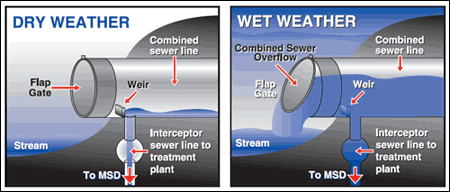The Challenge of Combined Sewer Overflows (CSOs)
Home About Us The Challenge of Combined Sewer Overflows (CSOs)
Louisville’s story is typical of the nation’s older cities. Many older U.S. cities built combined sewers to remove both wastewater and stormwater from areas where people lived. Combining wastewater and stormwater in a single pipe and designing the system to overflow during periods of heavy rainfall was considered state-of-the-art wastewater technology in the late 19th and early 20th centuries. It was not until the late 20th Century that experts began to realize that combined sewer overflows (CSOs) were contributing a sizeable amount of pollution to urban streams and rivers.
CSOs are outlets that dump excess water from the sewers into streams and rivers, keeping the sewers from backing up into homes, business and streets when it rains. In the combined sewer system (CSS), dry weather flows are conveyed to the Morris Forman WQTC for treatment prior to discharge into the Ohio River. During wet weather events, when the total combined sewage flow exceed the capacity of the sewer, a mixture of sewage and stormwater runoff is conveyed to the South Fork of Beargrass Creek, Middle Fork of Beargrass Creek, Muddy Fork of Beargrass Creek, and the Ohio River. The CSS service area is approximately one-third of the Morris Forman WQTC service area and encompasses approximately 37 square miles of area. Presently there about 100 active combined sewer overflows (CSOs) within the MSD service area.
In this simplified illustration, the combined sewer line is blocked by a low weir, or dam, before it reaches the stream. The weir diverts the flow into the interceptor sewer, which takes it to a sewage treatment plant. In dry weather, all of the flow is sanitary sewage, and the interceptor line can handle it. In wet weather, stormwater mixes with the sanitary sewage, increasing the flow. If the flow is too large for the interceptor to handle, part of the water may flow over the weir and through the CSO into the stream. Most overflows are equipped with valves that allow overflow water to enter the stream, but prevent stream water from entering the sewers. The simplest is the flap valve, shown here. Some valves may be inside the sewer lines, where they cannot be seen from the creek.

